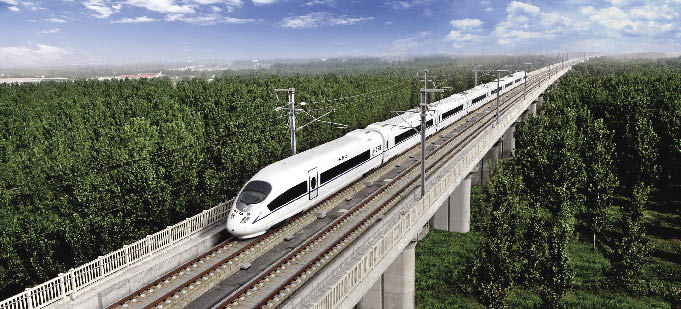| Rockets on the Rails
By staff reporter ZHAO HAIYAN
ON November 11, Chinese railway authorities once again modified the national train network – the third time in 2009. The purpose of such large-scale adjustments, covering vehicle modes, schedules and routes, was to make way for the introduction of 57 multiple unit trains of the latest model – the China Railway High-speed 3 (CRH3) – by the end of the year.
 |
|
A Harmony series train on China's first high-speed rail system – the Beijing-Tianjin intercity service is a less-than-30-minute commute. China Foto Press |
China kicked off its high-speed railway program in 2003, and by the spring of 2007 the first group of 15 domestically made CRH multiple unit trains was running between some major cities. On August 1, 2008, a week before the Beijing Olympic Games, the China-made CRH3 electric multiple unit, Harmony, was launched between Beijing and Tianjin, running that 130-kilometer leg at a record speed of 394.3 km/h, which then became known as "Chinese Speed" in both domestic and foreign media. In the first year of its operation the line ferried more than 18.7 million people, among whom were visiting state leaders and officials of international organizations from more than 30 nations.
Over the last two years China's investment in high-speed railway systems has been intensive, increasing the number of intercity MU trains to a total of more than 100. In the coming three years, the government will earmark about US $300 billion for railway construction to increase the total operation mileage to 30,000 kilometers, including 13,000 kilometers of special lines for high-speed trains that run faster than 350 kilometers per hour. By then 700 MU trains will be in operation. China plans to build intercity, high-speed rail systems in all its economically advanced areas within a decade, folding in the Bohai Rim, the Yangtze River Delta and the Pearl River Delta.
A highly efficient rail transport network will no doubt help remove the circulation bottlenecks that have been impeding the Chinese economy. Like the transcontinental railroads of the 19th century, the U.S. interstate highway system of the 1950s and 60s, and Japan's 20th-century Shinkansen bullet train system, this high-speed railway system promises to have a great impact on China, creating more and greater trade and development opportunities and putting the country's economic growth on an entirely new level.
Such effects are already strongly indicated by the rise of urban constellations and industrial belts around core cities and newly constructed high-speed rail and road lines. For example, the urban communities of the Yangtze River Delta have all been linked to Shanghai under a "one hour travel" program. Further south, a similar phenomenon has also extended Guangzhou. A "four-hour travel" network is currently being constructed with Wuhan, capital of Hubei Province, in the center and other metropolises like Beijing, Shanghai, Guangzhou and Xi'an, on the circumference. What today takes10 hours of travel time will be reduced to four or less.
The acceleration has seemed to shorten distances and affect people's concept of what is within range, and ultimately, what makes up their lifestyle. More and more people are willing to move out of large, crowded cities to satellite towns and shuttle between home and work.
Governments at various levels are encouraging such developments. Tianjin, for example, now a 30-minute ride from Beijing by the high-speed intercity rail system, has tried to lure the capital's residents by improving its infrastructure and public services, and providing as good a quality commodities at lower prices. Such efforts are winding up all over the country. China's rockets on rails are rocking the economy.
|
